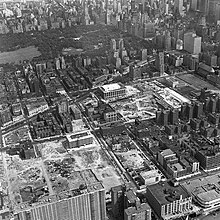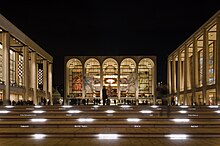San Juan Hill, Manhattan
San Juan Hill was a community in what is now the Lincoln Square neighborhood of the Upper West Side in Manhattan, New York City.
[3][4] Before the construction of Lincoln Center and the subsequent destruction of San Juan Hill, jazz and art thrived in this area as its popularity began to grow.
Mezzrow was introduced to jazz while living in Harlem, where he heard recordings of James P. Johnson, the pianist from San Juan Hill in which he said "Here’s a boy from the Jungles who makes all the other piano players look sick!”[5] Moreover, this basement club was where the Charleston dance was reputedly born and got its start.
[5] The area had numerous community and fraternal organizations, such as the Grand United Order of Odd Fellows, Negro Elks, and the Colored Freemasons.
Multiple musical traditions and sounds; Ragtime, Jazz Stride piano, Swing, Blues, Mambo, Paseo, Antillean Waltz, Calypso, Funk, Disco, Bebop along with historical film clips and interviews.
[12] San Juan Hill was mostly erased due to the mid-20th-century sweep of urban renewal to create Lincoln Center, displacing thousands of families, and removing the history that the neighborhood existed.
During this time, the displacement of more than 7,000 lower-class families and 800 businesses occurred, largely because of an increase in real estate prices resulting from the ongoing renewal process.
The Phipps Houses drew many families to the neighborhood seeking a healthy, safe and accessible living environment in which to raise their children, marking the beginnings of San Juan Hill's development in the first half of the twentieth century into a vibrant working-class district predominated by African Americans and (later) Puerto Ricans.
Weston recounted that her family had previously occupied a run-down tenement and had moved to Phipps in order to escape the deleterious environment of the slums.
[14] Writing-off the area of San Juan Hill as a slum was the first step in a post-WWII city redevelopment scheme that would spell the end of the working-class neighborhood.
These projects created housing for the middle class while displacing lower-income families and made room for the performing arts complex of Lincoln Center.
By 1955, Robert Moses struck a deal with the Met Opera to develop the neighborhood north of Columbus Circle into a home for the arts.
Other organizations such as Fordham University, the New York Philharmonic, and the Juilliard School of Music soon followed suit moved their headquarters and campuses to the center.
[21] Thelonious Monk, the jazz pianist, grew up in San Juan Hill, raised in the Phipps houses on West 63rd street.
[23]: 156, 174 Pianist James P. Johnson, one of the pioneers of the stride style of piano playing family moved to San Juan Hill in 1908.



